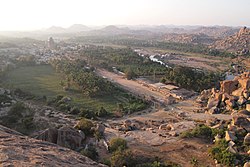Hampi
Vijayanagara | |
|---|---|
Town | |
 | |
| Coordinates: 15°20′06″N 76°27′43″E / 15.335°N 76.462°E | |
| Country | |
| State | Karnataka |
| District | Vijayanagara |
| Elevation | 467 m (1,532 ft) |
| Population (2011) | |
| • Total | 2,777[1] |
| Languages | |
| • Official | Kannada |
| Time zone | UTC+5:30 (IST) |
| PIN code | 583239 |
| Nearest city | Hosapete (Hospet) |
Hampi or Vijayanagara, known as kishkindha in the Ramayana age is a town in the Vijayanagara district in the Indian state of Karnataka.[2] Located along the Tungabhadra River in the east and center part of the state, Hampi is near the city of Hosapete. It is famous for hosting the Hampi Group of Monuments with the Virupaksha Temple, a UNESCO World Heritage Site.[3]
Hampi is mentioned in Ashokan epigraphy and texts such as the Ramayana and the Puranas of Hinduism as Pampaa Devi Tirtha Kshetra.[4][5][6] Hampi was a part of Vijayanagara, the capital of the Hindu Vijayanagara Empire in the 14th-century.[4][7] It became a center of economic and administrative activity of the Deccan region kingdom founded in opposition to Islamic Sultanates in South India. After over two centuries of rule, the Empire was defeated and abandoned. Since the 19th-century, its ruins have been an important site for archaeologists and historians.[7][8]
- ^ "Hampi Village Population - Hospet - Bellary, Karnataka". Census2011.co.in. Retrieved 11 August 2015.
- ^ Ballari:Hospet:Hampi Archived 10 January 2019 at the Wayback Machine, Official Website of Ballari District, Government of Karnataka
- ^ "Group of Monuments at Hampi". World Heritage. Retrieved 20 December 2006.
- ^ a b Anila Verghese (2002). Hampi. Oxford University Press. pp. 1–18. ISBN 978-0-19-565433-2.
- ^ John M. Fritz; George Michell; Clare Arni (2001). New Light on Hampi: Recent Research at Vijayanagara. Marg Publications. pp. 1–7. ISBN 978-81-85026-53-4.
- ^ D. Devakunjari (2007). World Heritage Series: Hampi. Eicher Goodearth Ltd, New Delhi - for Archaeological Survey of India. p. 8. ISBN 978-81-87780-42-7.
- ^ a b John M. Fritz; George Michell (2015). Hampi Vijayanagara. Jaico Publishing. pp. 11–23, backpage. ISBN 978-81-8495-602-3.
- ^ Joan-Pau Rubiés (2002). Travel and Ethnology in the Renaissance: South India Through European Eyes, 1250-1625. Cambridge University Press. pp. 234–236. ISBN 978-0-521-52613-5.
